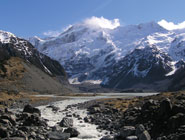The dissolved elements that give seawater its saltiness are mostly supplied by rivers which receive these elements from run-off (rainwater) that has interacted with and dissolved rocks, a process known as chemical weathering. The other major source of dissolved material in seawater is sub-marine hydrothermal vents that are found along mid-ocean ridges. Movement of seawater through the young, hot oceanic crust that is produced at these ridges causes the leaching out of some elements from sea-floor basalts. But at the same time, some of the constituents of seawater are precipitated out of solution on to the seafloor; thus hydrothermal systems are both a source of dissolved material to the oceans and also a means by which other material is lost. Another major output of material from the oceans goes to form sub-marine sediments, which are primarily made up of the dead remains of the shells of marine organisms. Imbalances in these inputs and outputs cause changes in the chemical make-up of the oceans through time.
Changes in ocean chemistry are driven by changes in the chemical breakdown of rocks
Deep-sea sediments also preserve a history of past ocean chemistry and record these changes through time. Vance and his team draw on records of this history to point out that some aspects of the chemistry of the oceans have been changing too slowly over the past 2-3 million years, if what we think we understand about the inputs and outputs to the modern ocean is correct. Specifically, the modern input from rivers to the oceans for some elements is so much bigger than the outputs that the oceanic concentrations of these elements should be increasing dramatically through time – but they are not.
Vance and colleagues go on to challenge the prevailing notion that this inconsistency is caused by inaccuracies in estimates of the impact of hydrothermal systems on ocean chemistry. Instead, they finger potential changes in continental chemical weathering rates – caused by profound climate change operating over the past 2-3 million years – and suggest that chemical weathering rates have been periodically perturbed in recent Earth history by the fact that ice-sheets produced by the great ice ages have physically ground rock up to smaller and smaller grain-sizes. In the succeeding hotter and wetter interglacial periods, this ground-up rock is very susceptible to chemical weathering, since all chemical reactions occur faster if the material on which the reaction is to occur is fine-grained – which is why school chemical experiments use iron filings instead of a block of steel!
No-one should make the mistake of thinking this extracts us from the predicament of high atmospheric CO2
One of the authors’ main conclusions is that in the instant of geological time represented by, say, the past 100 years, landscapes remain significantly perturbed by this process. The Earth emerged from the last Ice Age only 10,000 years ago and chemical weathering is still playing ‘catch-up’ with the massive amount of fertile, fine-grained substrate for chemical weathering that the Ice Ages produced. As a result, the measurements of the chemistry of rivers that scientists are currently making are not representative of river chemistry over the past few million years. They only represent now – and now is fairly meaningless in a geological context.
The team concludes by assessing some of the implications of its work. One of these is the potential impact on the natural greenhouse effect on our planet. Chemical weathering not only dissolves rock, it also causes atmospheric CO2 to react with those rocks, thereby taking CO2 out of the atmosphere. It eventually ends up in the oceans where it is incorporated into the calcium carbonate shells of marine organisms, which in turn die and accumulate in deep ocean sediment.
On long timescales – longer than hundreds of thousands of years – the amount of CO2 in the atmosphere normally represents a balance between the amount emitted as gas by volcanoes and the amount that gets taken out by chemical weathering. So the conventional view of the long-term evolution of Earth’s climate is that chemical weathering and CO2 act together to thermostatically regulate the Earth’s surface temperature. For example, if atmospheric CO2 increases for some reason, higher temperatures and more rain results in faster chemical weathering, which acts to get rid of the CO2. Vance and his team suggest, however, that during periods of Earth history when ice is a prominent feature of the surface environment, this thermostat could be over-ridden by the fact that cold temperatures lead to glaciers, which grind rock up. This in turn speeds up chemical weathering, leading to a more rapid removal of CO2 from the atmosphere. Thus, in periods like the last 2-3 million years, fast chemical weathering rates could act to maintain ‘icehouse’ conditions once they have started. But, Vance warns, no-one should make the mistake of thinking that any of this can extract us from the modern predicament of high atmospheric CO2. The natural processes discussed in this article are slow and while they may be crucial on geological timescales, ie, millions of years; they are irrelevant to the short span of human existence.

